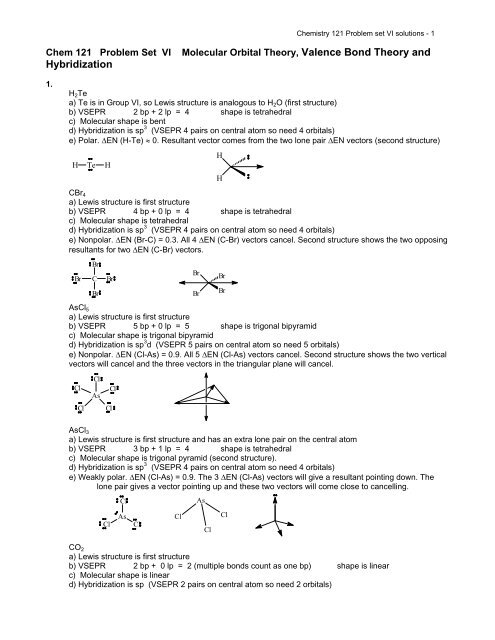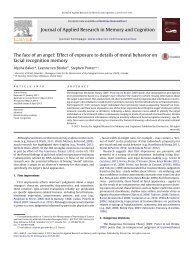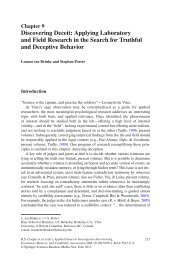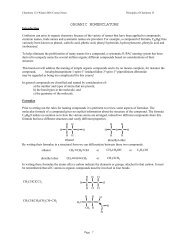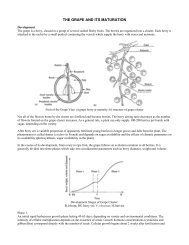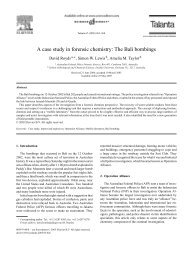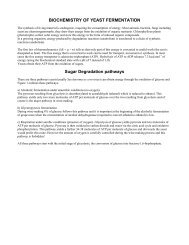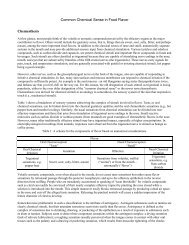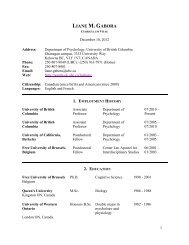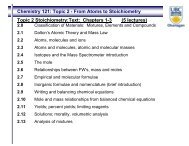Hybridization - People
Hybridization - People
Hybridization - People
Create successful ePaper yourself
Turn your PDF publications into a flip-book with our unique Google optimized e-Paper software.
Chemistry 121 Problem set VI solutions - 1<br />
Chem 121 Problem Set VI Molecular Orbital Theory, Valence Bond Theory and<br />
<strong>Hybridization</strong><br />
1.<br />
H2Te<br />
a) Te is in Group VI, so Lewis structure is analogous to H2O (first structure)<br />
b) VSEPR 2 bp + 2 lp = 4 shape is tetrahedral<br />
c) Molecular shape is bent<br />
d) <strong>Hybridization</strong> is sp 3 (VSEPR 4 pairs on central atom so need 4 orbitals)<br />
e) Polar. ∆EN (H-Te) ≈ 0. Resultant vector comes from the two lone pair ∆EN vectors (second structure)<br />
H<br />
Te H<br />
H<br />
H<br />
CBr4<br />
a) Lewis structure is first structure<br />
b) VSEPR 4 bp + 0 lp = 4 shape is tetrahedral<br />
c) Molecular shape is tetrahedral<br />
d) <strong>Hybridization</strong> is sp 3 (VSEPR 4 pairs on central atom so need 4 orbitals)<br />
e) Nonpolar. ∆EN (Br-C) = 0.3. All 4 ∆EN (C-Br) vectors cancel. Second structure shows the two opposing<br />
resultants for two ∆EN (C-Br) vectors.<br />
Br<br />
Br<br />
C<br />
Br<br />
Br<br />
Br<br />
Br<br />
Br<br />
Br<br />
AsCl5<br />
a) Lewis structure is first structure<br />
b) VSEPR 5 bp + 0 lp = 5 shape is trigonal bipyramid<br />
c) Molecular shape is trigonal bipyramid<br />
d) <strong>Hybridization</strong> is sp 3 d (VSEPR 5 pairs on central atom so need 5 orbitals)<br />
e) Nonpolar. ∆EN (Cl-As) = 0.9. All 5 ∆EN (Cl-As) vectors cancel. Second structure shows the two vertical<br />
vectors will cancel and the three vectors in the triangular plane will cancel.<br />
Cl<br />
Cl<br />
As<br />
Cl Cl<br />
Cl<br />
AsCl3<br />
a) Lewis structure is first structure and has an extra lone pair on the central atom<br />
b) VSEPR 3 bp + 1 lp = 4 shape is tetrahedral<br />
c) Molecular shape is trigonal pyramid (second structure).<br />
d) <strong>Hybridization</strong> is sp 3 (VSEPR 4 pairs on central atom so need 4 orbitals)<br />
e) Weakly polar. ∆EN (Cl-As) = 0.9. The 3 ∆EN (Cl-As) vectors will give a resultant pointing down. The<br />
lone pair gives a vector pointing up and these two vectors will come close to cancelling.<br />
Cl<br />
As<br />
Cl Cl<br />
Cl<br />
As<br />
Cl<br />
Cl<br />
CO2<br />
a) Lewis structure is first structure<br />
b) VSEPR 2 bp + 0 lp = 2 (multiple bonds count as one bp) shape is linear<br />
c) Molecular shape is linear<br />
d) <strong>Hybridization</strong> is sp (VSEPR 2 pairs on central atom so need 2 orbitals)
e) Nonpolar. ∆EN (O-C) = 1. The 2 opposing ∆EN (O-C) vectors cancel.<br />
O C O<br />
Chemistry 121 Problem set VI solutions - 2<br />
IF5<br />
a) Lewis structure is first structure and has an extra lone pair on the central atom<br />
b) VSEPR 5 bp + 1 lp = 6 shape is octahedral<br />
c) Molecular shape is square pyramid (second structure).<br />
d) <strong>Hybridization</strong> is sp 3 d 2 (VSEPR 6 pairs on central atom so need 6 orbitals)<br />
e) Weakly polar. ∆EN (F-I) = 1.5. The 4 ∆EN (F-I) vectors in the square plane will cancel. The ∆EN (F-I)<br />
vector will come close to cancelling with the lone pair vector.<br />
F<br />
F<br />
I<br />
F<br />
F F<br />
F<br />
F<br />
F I F<br />
F<br />
SF4<br />
a) Lewis structure is first structure and has an extra lone pair on the central atom<br />
b) VSEPR 4 bp + 1 lp = 5 shape is trigonal bipyramidal<br />
c) Molecular shape is seesaw (second structure).<br />
d) <strong>Hybridization</strong> is sp 3 d (VSEPR 5 pairs on central atom so need 5 orbitals)<br />
e) Weakly polar. ∆EN (F-S) = 1.5. The 2 ∆EN (F-S) vectors in the vertical plane will cancel. The resultant<br />
of the two ∆EN(F-S) vectors will come close to cancelling with the lone pair vector in the horizontal<br />
triangular plane.<br />
F<br />
F<br />
S<br />
F<br />
F<br />
F<br />
F<br />
F<br />
F<br />
ICl3<br />
a) Lewis structure is first structure and has two extra lone pairs on the central atom<br />
b) VSEPR 3 bp + 2 lp = 5 shape is trigonal bipyramidal<br />
c) Molecular shape is T shaped (second structure).<br />
d) <strong>Hybridization</strong> is sp 3 d (VSEPR 5 pairs on central atom so need 5 orbitals)<br />
e) Polar. ∆EN (Cl-I) = 0.5. The 2 ∆EN (F-S) vectors in the vertical plane will cancel. The resultant of the<br />
two lone pair vectors will be much greater than the ∆EN (F-S) vector in the horizontal triangular plane.<br />
Cl<br />
Cl<br />
I Cl<br />
Cl<br />
Cl<br />
Cl<br />
XeF2<br />
a) Lewis structure is first structure and has three extra lone pairs on the central atom<br />
b) VSEPR 2 bp + 3 lp = 5 shape is trigonal bipyramidal<br />
c) Molecular shape is linear, lone pairs go into the horizintal trigonal plane. (second structure).<br />
d) <strong>Hybridization</strong> is sp 3 d (VSEPR 5 pairs on central atom so need 5 orbitals)<br />
e) Nonpolar. ∆EN (F-Xe) = 1.4. The 2 ∆EN (F-Xe) vectors in the vertical plane will cancel. The 3 lone pair<br />
vectors in the horizontal triangular plane will cancel.
F<br />
Xe F<br />
F<br />
F<br />
Chemistry 121 Problem set VI solutions - 3<br />
NO2 -<br />
a) Lewis structure is first structure and and has a formal charge on one oxygen to give a net charge of -1.<br />
Nitrogen forms one double bond and there are two resonance hybrids.<br />
b) VSEPR 2 bp + 1 lp = 3 (multiple bonds count as one bp) shape is trigonal.<br />
c) Molecular shape is bent. (second structure).<br />
d) <strong>Hybridization</strong> is sp 2 (VSEPR 3 pairs on central atom so need 3 orbitals)<br />
e) Polar and the resultant of the two NO vectors will not cancel with the lone pair vector. Molecule has a<br />
net negative charge.<br />
O<br />
N<br />
O<br />
O<br />
O<br />
2. CA VSEPR 4 bp + 0 lp = 4 pair tetrahedral<br />
<strong>Hybridization</strong> sp 3 (VSEPR 4 pairs on central atom so need 4 orbitals)<br />
CB VSEPR 3 bp + 0 lp = 3 pair trigonal planar (multiple bonds count as one bp)<br />
<strong>Hybridization</strong> sp 2 (VSEPR 3 pairs on central atom so need 3 orbitals)<br />
3. a) CH3CH3<br />
H<br />
H<br />
C<br />
H<br />
H<br />
C H<br />
H<br />
Carbon VSEPR: 4 bp + 0 lp = 4 pairs; tetrahedral and hybridization is sp 3<br />
2<br />
2s<br />
sp 3<br />
Carbon<br />
The six carbon-hydrogen bond orbitals in ethane result from the over lap of sp 3 orbitals on the carbon<br />
atoms and 1s orbitals on the hydrogen atoms. The carbon-carbon bond orbital results from the overlap of<br />
two sp 3 orbitals, one from each carbon atom. There are (6 x 1) + (2 x 4) = 14 valence electrons in ethane.
Chemistry 121 Problem set VI solutions - 4<br />
Each of the seven bond orbitals is occupied by two valence electrons of opposite spins, accounting for<br />
the seven bonds in ethane.<br />
b) CH3OH<br />
H<br />
H<br />
C<br />
H<br />
O H<br />
Carbon VSEPR: 4 bp + 0 lp = 4 pairs; tetrahedral and hybridization is sp 3 (energy diagram as above)<br />
Oxygen VSEPR: 2 bp + 2 lp = 4 pairs; tetrahedral and hybridization is sp 3<br />
2<br />
2s<br />
sp 3<br />
Oxygen<br />
The three carbon-hydrogen bond orbitals and the oxygen-hydrogen bond orbital in methanol result from the<br />
overlap of sp 3 orbitals and 1s orbitals on the hydrogen atoms. The carbon-oxygen bond orbital results from<br />
the overlap of a carbon sp 3 orbital and an oxygen sp 3 orbital. Ten of the valence electrons (4 x 1) + 4 + 6 =<br />
14 in methanol occupy five bond orbitals and the other four valence electrons occupy the two remaining sp 3<br />
orbitals as lone pairs on the oxygen atom.<br />
c) Ethene<br />
H<br />
H<br />
C<br />
C<br />
H<br />
H<br />
Carbon VSEPR: 3 bp + 0 lp = 3 pairs; trigonal planar and hybridization is sp 2<br />
2 2p<br />
2s<br />
sp 2<br />
Carbon
Chemistry 121 Problem set VI solutions - 5<br />
All six atoms of the ethene molecule lie in one plane. The first diagram shows the two sp 2 hybridized<br />
carbon atoms, each with three sp 2 orbitals and one remaining 2p orbital. Each orbital contains one electron<br />
as shown in the energy diagram. The second diagram shows the σ framework. The four carbon-hydrogen<br />
bond orbitals result from the overlap of carbon sp 2 orbitals and hydrogen 1s orbitals. The two carbon atoms<br />
are joined by the overlap of an sp 2 orbital from each. The resulting bond orbital is cylindrically symmetric<br />
around the carbon-carbon axis and is therefore a σ bond orbital., as are the carbon-hydrogen bond orbitals.<br />
Finally the last diagram shows the overlap of the two 2p orbitals to form a π bond, the second bond in the<br />
double bond. There are (2 x 4) + 4 x 1) = 12 valence electrons in ethene, 10 of these occupy the five σ<br />
bonds and the last two occupy the π bond.<br />
d) Ethyne<br />
H C C H<br />
Carbon VSEPR: 2 bp + 0 lp = 2 pairs; linear and hybridization is sp<br />
2 2p<br />
2s<br />
sp<br />
Carbon<br />
The first diagram shows the σ bond framework for ethyne. The carbon-carbon σ bond orbital results from<br />
overlapping two sp orbitals, one from each carbon atom. Each of the two carbon-hydrogen σ bond orbitals<br />
results from overlapping a carbon sp orbital and a hydrogen 1s orbital. When carbon is sp hybridized, there<br />
are two 2p orbitals, each with one electron, unused (energy diagram). The second diagram shows the 2p<br />
orbitals from both carbons (one set along the y-axis and the other set along the z-axis). The 2py orbitals<br />
from each carbon overlap to form a π bond orbital, as do the 2pz orbitals to form a second π bond orbital.<br />
The two π bonds in ethyne (acetylene) constitute a barrel-shaped distribution of electron density in the<br />
bond region.<br />
e) Carbon monoxide
C O<br />
Carbon VSEPR: 1 bp + 1 lp = 2 pairs; linear and hybridization is sp<br />
2 2p<br />
2s<br />
sp<br />
Carbon<br />
Oxygen VSEPR: 1 bp + 1 lp = 2 pairs; linear and hybridization is sp<br />
2 2p<br />
2s<br />
sp<br />
Oxygen<br />
Chemistry 121 Problem set VI solutions - 6<br />
The hybridization for carbon is sp and one of the sp orbitals contains a lp and the other a bp. There are two<br />
remaining 2p orbitals each occupied by one electron. Thus carbon has five valence electrons; note the<br />
negative formal charge on carbon in the Lewis structure. The hybridization for oxygen is sp and one of the<br />
sp orbitals contains a lp and the other a bp. There are two remaining 2p orbitals each occupied by one<br />
electron. Thus oxygen has five valence electrons; note the positive formal charge on carbon in the Lewis<br />
structure. The carbon-oxygen σ bond orbital results from overlapping the two sp orbitals, each contributing<br />
one electron. The two π bonds (a triple bond results from a σ bond and two π bonds) result from the<br />
overlap of the two 2py orbitals on carbon and oxygen and the two 2pz orbitals as in ethyne. Carbon<br />
monoxide has (4 + 6) = 10 valence electrons, two occupy the σ orbital, four occupy the two π orbitals and<br />
the other four occupy the two remaining sp orbitals on carbon and oxygen as lone pairs.
4.<br />
2p<br />
2s<br />
*<br />
2py 2p y<br />
2p x<br />
*<br />
2px<br />
2s<br />
*<br />
2s<br />
*<br />
2pz 2p z<br />
2p<br />
2s<br />
2p<br />
2s<br />
*<br />
2py 2p y<br />
2p x<br />
*<br />
2px<br />
2s<br />
*<br />
2s<br />
*<br />
2pz 2p z<br />
Chemistry 121 Problem set VI solutions - 7<br />
Species N2 + N2 N2 -<br />
Valence electrons 9 10 11<br />
Bond Order<br />
(9 − 4)<br />
= 2.5<br />
2<br />
(10 − 4)<br />
= 3<br />
2<br />
(10 − 5)<br />
= 2.5<br />
2<br />
Magnetism paramagnetic diamagnetic paramagnetic<br />
Bond strength N2 > N2 + = N2 −<br />
5a)<br />
*<br />
2py 2p y<br />
2px<br />
*<br />
2px<br />
2s<br />
*<br />
2p z<br />
2s<br />
*<br />
2s 2s 2s 2s<br />
1s<br />
*<br />
*<br />
2pz *<br />
2py 2p y<br />
2px<br />
*<br />
2px<br />
1s<br />
*<br />
*<br />
2pz 2p z<br />
1s 1s 1s 1s<br />
*<br />
2py 2p y<br />
2p<br />
2s<br />
2px<br />
*<br />
2s<br />
*<br />
1s<br />
*<br />
*<br />
2pz 2p z<br />
2p<br />
2s<br />
*<br />
2py *<br />
2py 2p y<br />
2py<br />
2px<br />
*<br />
2px<br />
2s<br />
*<br />
2px 2px<br />
Species O2 + O2 O2 - O2 2-<br />
Total electrons 15 16 17 18<br />
Bond Order<br />
(10 − 5)<br />
= 2.5<br />
2<br />
(i) weakest bond is<br />
2-<br />
O2<br />
(10 − 6)<br />
= 2<br />
2<br />
(10 − 7)<br />
= 1.5<br />
2<br />
2s<br />
2px<br />
*<br />
2s<br />
*<br />
1s<br />
*<br />
*<br />
2pz 2p z<br />
*<br />
2pz 2pz<br />
(10 − 8)<br />
= 1<br />
2<br />
2p<br />
2s
5b)<br />
(ii) shortest bond is O2 +<br />
σ ∗ 2p<br />
π∗ 2p π∗ 2p<br />
π 2p<br />
σ 2p<br />
σ ∗ 2s<br />
σ 2s<br />
σ ∗ 1s<br />
σ 1s<br />
π 2p<br />
σ ∗ 2p<br />
π∗ 2p π∗ 2p<br />
π 2p<br />
σ 2p<br />
σ ∗ 2s<br />
σ 2s<br />
σ ∗ 1s<br />
σ 1s<br />
π 2p<br />
Chemistry 121 Problem set VI solutions - 8<br />
σ ∗ 2p<br />
π∗ 2p π∗ 2p<br />
Species NO CN - B2<br />
Total electrons 15 14 10<br />
Unpaired electrons 1 0 2<br />
Increasing paramagnetism CN - < NO < B2<br />
π 2p<br />
σ 2p<br />
σ ∗ 2s<br />
σ 2s<br />
σ ∗ 1s<br />
σ 1s<br />
π 2p


